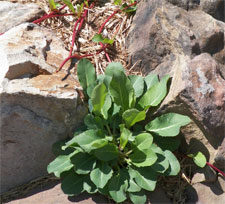Native Son: Riding Shotgun with Sperry
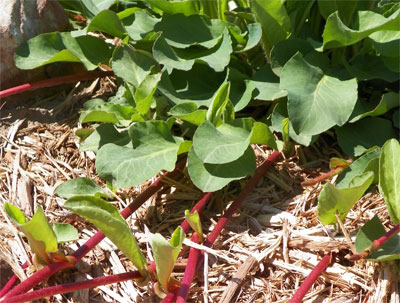
Colorful “stolon-zomes” of yerba mansa. Photos by Steven Chamblee.
It was indeed an honor and a privilege to tag along with Neil Sperry during one of his busy days recently. I am well aware that Neil is always on guard against self-promotional “puff pieces,” so he may well not include this in his e-newsletter. That in mind, I write this not for Neil, but for you folks out there who take the time to join me monthly on my various forays into this wonderful world. Allons!

Japanese maples blaze red in the spring sunshine.
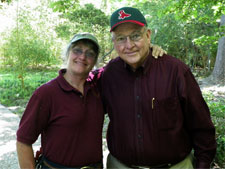
Gardener Mary Horvath shared stories with Neil in the Japanese Garden.
I pull into the very last parking spot in front of the Japanese Garden at the Fort Worth Botanic Garden, figuring this is a good omen for the day ahead. I’m here to check out the new Children’s Garden dedication, meet up with Neil Sperry, soak myself in the insane beauty of springtime in the Japanese Garden, then join Neil on his day out and about in Cowtown.
The Children’s Garden is inspiring, its dedication short and sweet, and I have brief reunions with many wonderful people I’ve been fortunate enough to work with through the years. But I must admit I’m a little antsy, for I know the clock is ticking and just 100 yards thataway is that magical marvel of maples, that colony of colorful koi, that amazing maze of divine pathways called the Japanese Garden. Even before you step inside, the outer courtyard mesmerizes with brilliant colors, colossal blossoms, and that sculptural sui generis, the three-tiered ginkgo tree.
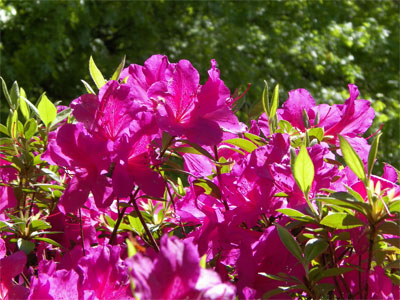
Azaleas light up the Japanese Garden in Fort Worth.

Exploring one of the many bamboo groves is a unique experience in the Japanese Garden.
Just past the gate, you are immersed in an ethereal world and must choose between many paths, just as in life itself. Upon choosing, you are immediately rewarded with the fruits of your good decision (perhaps a bit unlike life itself). Gentle, sweeping curves rise and fall, pulling you in like a hidden magnet. Stone, bark, and earth become one. Land and water meld seamlessly into a fantastic mirrored tableau, punctuated with swimming colors. Reality finally releases its grasp, and you succumb to the omnipotent forces of sky and spirit. Minute details emerge, seemingly from everywhere, as your inner vision becomes more acute, and you feel the ebb and flow of nature all around you, pulsing within you. The connection complete, you hold the universe in the palm of your hand. For me, this journey is familiar, yet new again. Memories flutter all around me, like leaves on the trees; some old, some new. Others have simply fallen away, washed downstream forever.
A low growl from my stomach makes me smile, and Neil says, “Yeah, I’m hungry, too.”
Lunch with Neil in Fort Worth means Angelo’s Barbecue, and we reminisce a bit about our experiences there … sawdust on the floor, old friends, local celebrities … and note the new taxidermy bear out front (this one still has its claws). Angelo’s opened the year before I was born, and my father first brought me here in 1977. I’ve been hooked ever since.
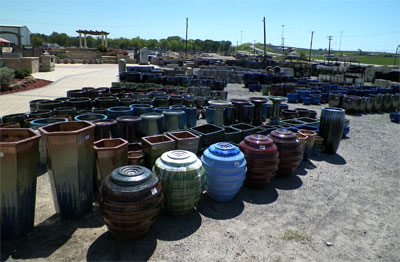
Just a part of the ocean of goodies at Whiz-Q Stone.
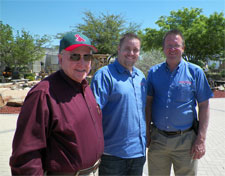
Neil chats with Derek and Mike Whisenand.
We pull into Whiz-Q Stone, and my jaw drops. Has it been that long since I’ve been here? The place was huge then; it’s wonderfully monstrous now! Twenty-two acres of hardscape bliss … boulders, cut stone, soils, mulches, pavers, pergolas, furniture, fireplaces, grills, and an amazing array of containers, pots, fountains, pumps, pools, and demonstration gardens. Two hundred kinds of natural stone … enough to make even a seasoned geologist dizzy … just blows my mind. I leave Neil chatting with owners Mike and Derek Whisenand while I rummage around like a lunatic, slapping stones, ogling obelisks, caressing containers, photographing some of the demonstration gardens … when I run into my old friend, Yerba Mansa.
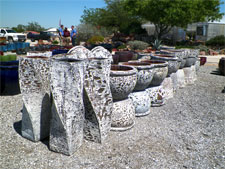
Steven’s favorite pots at Whiz-Q.
Yerba mansa (her parents call her Anemopsis californica) is a lovely plant native to northern Mexico and the southwestern U.S., including just a few locations on the far tip of West Texas. Far different from other plants hailing from that region, yerba mansa is a lush, green, perennial herb with very fragrant leaves that are scented somewhat like ginger-infused eucalyptus. And, yes, “lush green” means its natural range is strictly limited to the edges of streams and waterways. This very narrow range, coupled with the plant’s popularity as a medicinal herb, eventually led to it almost disappearing from the wild. Fortunately, it is very easy to propagate from both seed and cuttings, so this has led to agricultural production of yerba mansa for medicinal and potpourri purposes, and nursery production as an ornamental groundcover for avid gardeners.
As wonderful as the thick, blue-tinged, 5-inch-long leaves are, there is much more to this plant than the foliage. Yerba mansa is an early summer bloomer in North Texas, sporting an interesting, cone-shaped spike of tiny flowers, each subtended by a tiny, spoon-shaped bract. The entire cone is subtended by large white bracts, giving an overall appearance similar to an all-white Mexican coneflower. I initially recognized the family connection to another plant because of the flower similarity — chameleon plant (Houttuynia cordata), another member of the Lizard Tail family. (I kid you not.)
While it certainly requires plenty of water to get started, it’s actually quite tough once established. Bright red “stolon-zomes” are not only curiously beautiful, they root easily at the nodes, developing into sturdy clumps of root mass that resist desiccation and erosion, eventually leading to colonies. These colonies are often cultivated under palm clusters, particularly in California gardens.
Yerba mansa is also a “halophyte,” a term used to describe plants that live in salty or highly alkaline soils. It typically grows in “cienegas” (small, spring-fed alkaline marshes), where they serve as pioneer species that eventually acidify and enrich these harsh micro-environments, making them suitable for other species. Cool, eh? I think so, too, until I see Neil’s truck pulling away. He is all loaded up and ready to go, yet still nice enough to circle around and pick me up. (I do admire his ability to get my attention.)
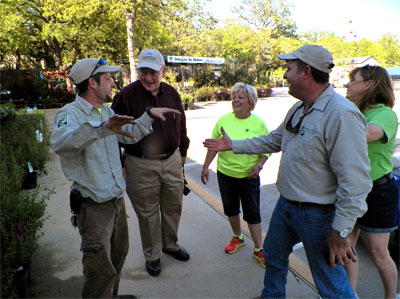
Plant people in action: Kyle Hawkins (left) leads the chorus in a spirited conversation.
Pulling into Designs by Nature, we are greeted by a dozen enthusiastic folks with hearty smiles, one of which was familiar to me. Nursery manager Kyle Hawkins was a student of mine once upon a time at Tarrant County College. I remember him specifically, not only for being highly motivated and downright fun, but for being the first person I knew who had a smart phone. I would call on him regularly during class for quick Internet searches to make sure I was giving out the latest information. By the third week of the semester, I could just look at him and he’d say, “I’m on it.” He had www.aggiehorticulture and www.brit.org down pat.
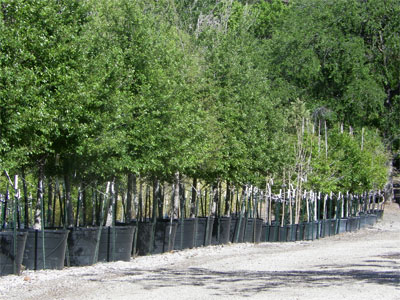
Acres of containerized trees at Gardens By Design await their journey to new homes across North Texas.
These days, Kyle has found a home at a rather amazing nursery. And though they call it “The Tree Place” (www.thetreeplace.com) for a darn good reason, it is so much more than that. Annuals, perennials, accents, groundcovers, shrubs, pots, sculptures, soil amendments, fertilizers, and all the accoutrements you could ever need, including dinosaurs. (You’ll just have to see them to believe them.) But no doubt about it, trees are the main event at this nursery, and they’ve got acres of them. We all pile on the golf cart for a tour with owner Robert Hafkesbring at the wheel. NASCAR’s got nothin’ on this guy … I think we even do some “drifting” back by the maples. Five plant nuts flying around a nursery, playing plant ID and swapping stories; these are good times. I even get introduced to a new plant, the ‘Empire Live Oak’.

Left photo: ‘Empire Live Oak’ maintains an upright growth habit. Right photo: The light-colored bark of ‘Empire Live Oak’ is distinctive.
In a nutshell, some folks wanted to consistently produce genetically superior live oaks in large numbers, so they painstakingly located a few special trees with the desired traits (upright form, tight habit, wide angle branching, and fast growth) and relocated them to an isolated area of a nursery in Glen Flora, Texas. The acorns produced by this small population of thoroughbreds give rise to seedlings with these same traits, and now we’re off to the races. (Full story at click here.) Aside from the straight central trunk, I find the smooth, light-colored bark fascinating; reminds me of a yaupon holly.
In a flash, Neil is dropping me off back at the Fort Worth Botanic Garden. I tell him I am so inspired, I could write a limerick using Robert Hafkesbring’s name. Neil laughs, and says he’ll buy me another lunch at Angelo’s if I can pull that one off. Hmmm….
I bought a young cow from Robert Hafkesbring,
With full intent to teach that smart calf to sing,
As soon I got him to howl,
He was bought by one Simon Cowell,
So I now get the last laugh, ka-ching!
“Sliced brisket plate, with all the trimmings, please. Why yes, I would like extra onions.”
About the author: Steven Chamblee is the chief horticulturist for Chandor Gardens in Weatherford and a regular contributor to Neil Sperry’s GARDENS magazine and e-gardens newsletter. Steven adds these notes:
Come see Chandor Gardens while she wears her glorious spring cloak of blossoms! Go to www.chandorgardens.com for details. Just take I-20 west to exit 409, hang a right, go 2.1 miles and hang a left on Lee Avenue. Head straight 12 blocks and you’re driving in the gates. Call 817-361-1700 for more information.
I can always use another road trip! Let me know if you’d like me to come out and speak to your group sometime. I’m low-maintenance, flexible, and you know I like to go just about anywhere. No city too big; no town too small. Just send me an e-mail at schamblee@weatherfordtx.gov and we’ll work something out.


